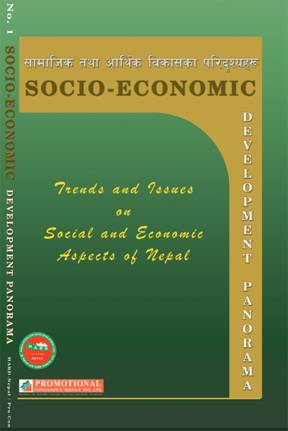Dr. Narayan Prasad Bhattarai (Dec 2005). <i>Hydropower Development in Nepal: A Study of Demand for Electricity and Financial Requirement up to 2030</i>. Published by Devi Kumari Bhattarai, Anamnagar, Kathmandu, Nepal
Abstract
Dr. Narayan Prasad Bhattarai (Dec 2005). Hydropower Development in Nepal: A Study of Demand for Electricity and Financial Requirement up to 2030. Published by Devi Kumari Bhattarai, Anamnagar, Kathmandu, Nepal, Price Rs. 1000.00 (Hard Cover), RS. 500.00 (Soft Cover), ISBN: 99946-57-97-6 (Hard Cover), ISBN: 99946-58-00-X (Soft Cover).
The history of economic development of the countries of the world shows water resources as the life-blood of their overall development. As Nepal is the second richest country of the world in water resources, we need to achieve prosperity by harnessing the abundant water resources. More than eight decades have already elapsed since Nepal initiated efforts towards hydropower development. Various types of Hydropower projects - small, medium and large - have been built by utilizing several rivers of the country.
However, we have not yet been able to develop even one percent of the total potentials (83,000 megawatts) and provide electricity to a quarter of the total population. The problems or the challenges of the Hydropower development such as selection of the projects and appropriate managing finance for them have not been given due attention. And there is dearth of knowledge or information about the Hydropower Development in Nepal.
In this regard, the book by Dr. Narayan Prasad Bhattarai can be considered a fruitful attempt to fill this gap. The book consists of six chapters. The first chapter presents general aspect of Nepal and an overview of Nepali economy. Chapter two reviews studies regarding the hydropower development and presents scope, objectives, and methodology of the study. The main objectives of the study are to estimate financial resources for the development of hydropower for the next 30 years.
The specific objectives of the study are to present the existing status of hydropower development regarding generation and consumption of electricity and investment in this sector, analyze the pattern of financial resources allocation to hydropower development and assess the role played by foreign assistance in the development of hydropower projects and estimate the electricity demand and the investment requirement for the next 30 years.
Development of medium size hydro electricity-projects in general and micro power projects in particular are recommended for Nepal.
Chapter three and four analyses the main aspects of the energy sectors of development, and production and consumption of electricity and investment, respectively. Chapter five, which can be considered as the most important chapter of the study, is devoted to the projections of the demand and investment requirement of electricity production. Finally, chapter six presents summary and recommendations.
The literature review chapter is focused mainly on hydropower development strategy, issue of downstream benefits and small versus large hydropower projects. However, the review appears to have left the literature of the periods of hydropower development in Nepal. Besides, it seems to have paid less attention to the theoretical aspects of resource utilization.
The role of foreign aid in hydropower development is well discussed including its disadvantages. And the book underscores the necessity to explore alternative resources of finance for hydropower development.
In order to accomplish the objectives, the study has analyzed the behavior and determinants of electricity production, consumption and investment in hydropower sector. The analysis is based on macro economic variables and secondary data. For the next 30 years, the projections are based on various parameters of demand and investment derived quantitatively by using lest squire regression technique. The author also presents financing scheme of the required investment in terms of domestic and foreign components.
Demand for electricity is assumed to be equal to internal consumption plus import. The consumption function is based on proxy Variables. However, the study has well convincingly estimated the functions and parameters. It has been estimated that more the demand for hydro electricity of 161394.92 mkwh for 2029/30, which is about 85 times greater than that for 2000/01 (1891.81mkwh).
The requirement of total amount of domestic sources for the year 2029/30 is estimated to be Rs. 637993.38 million, which is 34 times greater than that for 2000/01 (Rs. 17472.81). And the demand for hydropower could be met through internal production. The writer has also derived various important parameters such as capital output ratio in hydropower electricity using innovative tools and techniques.
The development of medium sized hydro electricity projects in general and micro power projects in particular are recommended for Nepal. Regarding the need of the financial resources, the study has recommended that preferences should be given to mobilize domestic financial resources by encouraging private sector investment. The book is well designed. However, there are some errors relating to typography and bibliography. And the price is costly for an ordinary reader.
The book has well shed light on various important aspects of the hydropower development in Nepal in a very lucid manner. Planners and policy makers may get valuable insights from the book. It may also be very useful for the researchers and academic people interested in natural resources.
Socio-Economic Development Panorama Vol.1(1) 2007 pp.145-148

